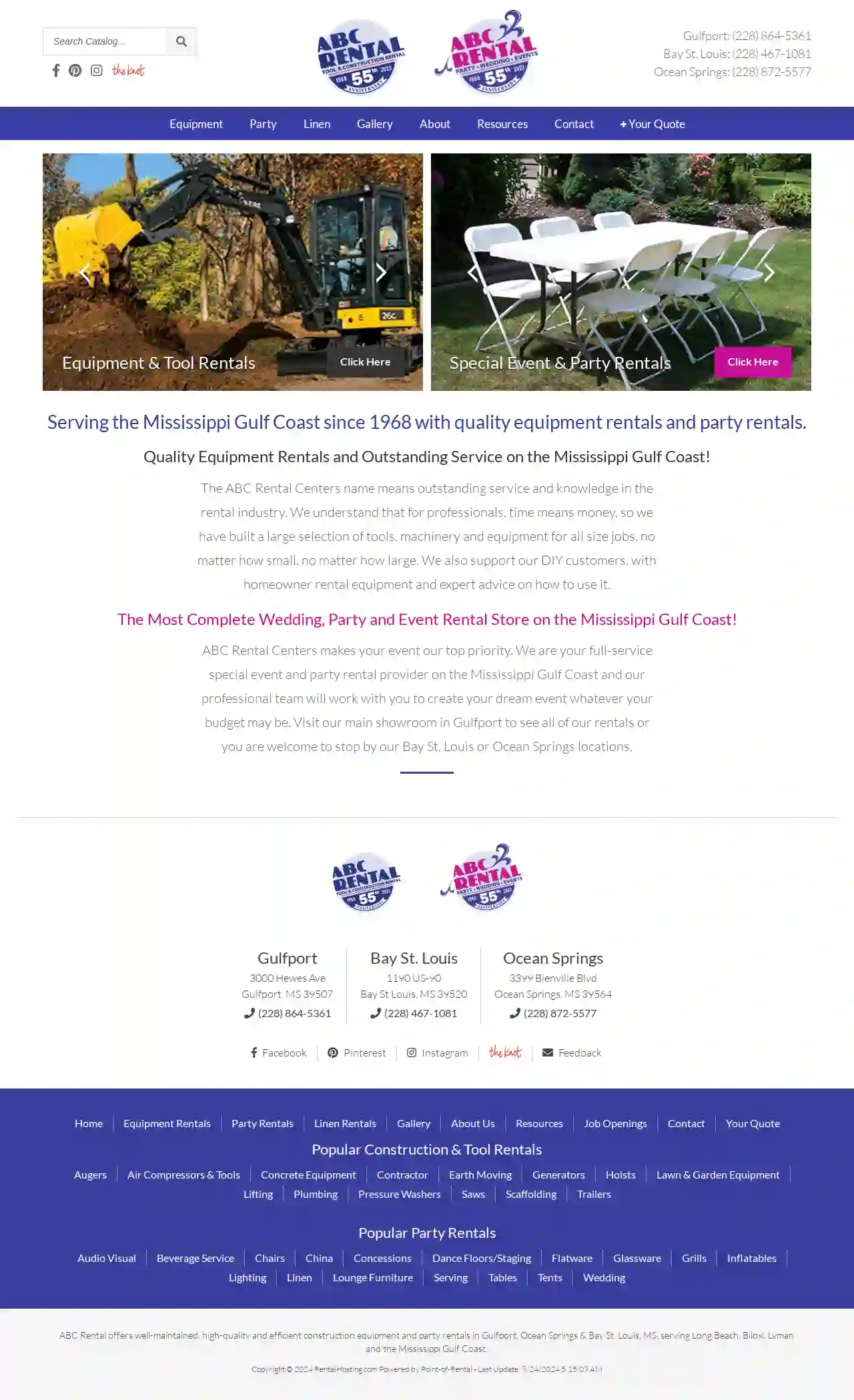Scaffolding Companies Byram
Best Scaffolding Companies in Byram
Get multiple Scaffolding Solutions quotes for your project today! Compare profiles, reviews, accreditations, portfolio, etc... and choose the best offer.
Service Needed
City or Town

ABC Rental Center
4.4151 reviews3000 Hewes Ave, Gulfport, 39507, USABC Rental offers well-maintained, high-quality and efficient construction equipment and party rentals in Gulfport, Ocean Springs & Bay St. Louis, MS, serving Long Beach, Biloxi, Lyman and the Mississippi Gulf Coast. With a wide range of equipment and party rentals, ABC Rental is dedicated to providing outstanding service and knowledge in the rental industry.
- Services
- Why Us?
- Gallery
Get Quote- Ma
Magnolia Masonry of South Mississippi LLC
4.914 reviewsGulfport, US- Services
- Why Us?
Get Quote - Lo
Lowe's Home Improvement
4.1Gulfport, US- Services
- Why Us?
Get Quote - Th
The Home Depot
4.2Gulfport, US- Services
- Why Us?
Get Quote - Cr
Crom Equipment Rentals Inc
Gulfport, US- Services
- Why Us?
Get Quote
Over 2,353+ Scaffolding Companies registered
Our scaffolding companies operate in Byram & beyond!
ScaffoldingHQ has curated and vetted the Best Scaffolding Businesses near Byram. Find a reliable business today.
Frequently Asked Questions About Scaffolding Companies
Find answers to common questions about scaffolding companies and hiring scaffolding contractors in the USA.
- Mobile Elevated Work Platforms (MEWPs): Scissor lifts, boom lifts, and other MEWPs offer flexible access for specific tasks.
- Mast Climbing Work Platforms (MCWPs): Ideal for high-rise construction, providing a stable working platform that can be raised incrementally.
- Suspended Access Equipment: Ropes and harnesses used for specific tasks like window cleaning or façade repairs.
- Ladders and Step Ladders: For shorter durations and limited working heights, provided they are used safely and appropriately.
- Communicate with the Scaffolding Company: Clearly express your concerns about potential damage to landscaping, structures, or utilities.
- Clear the Area: Remove any valuable or fragile items from the work zone.
- Protect Landscaping: Cover plants, shrubs, and lawns with tarps or protective sheeting.
- Mark Underground Utilities: Ensure underground utilities (water lines, electrical cables) are marked and avoided during installation.
- Supervision: If possible, be present during erection and dismantling to monitor the process.
- Steel: The most common material due to its strength, durability, and resistance to corrosion.
- Aluminum: Lighter than steel, often used for smaller projects or where weight is a concern.
- Timber: Used for decking platforms and some traditional scaffolding structures. It's less common now due to its susceptibility to rot and damage.
- Fiberglass: Used in specialized applications where electrical conductivity is a concern.
- Online Directories: Use specialized directories like ScaffoldingHQ to search for scaffolding companies in your area.
- Search Engines: Use Google or other search engines to search for 'scaffolding companies near me' or 'scaffolding rental [your location]'.
- Local Construction Associations: Contact local construction associations for recommendations.
- Word-of-Mouth Referrals: Ask friends, family, or colleagues for recommendations based on their past experiences.
What are some alternatives to traditional scaffolding?
Depending on the project, these alternatives may be suitable:
How do I protect my property from damage during scaffolding erection and dismantling?
To protect your property:
What are some common materials used in scaffolding?
Scaffolding is typically constructed from durable materials:
How can I find scaffolding companies near me?
Finding local scaffolding companies is easy:
What are some alternatives to traditional scaffolding?
Depending on the project, these alternatives may be suitable:
- Mobile Elevated Work Platforms (MEWPs): Scissor lifts, boom lifts, and other MEWPs offer flexible access for specific tasks.
- Mast Climbing Work Platforms (MCWPs): Ideal for high-rise construction, providing a stable working platform that can be raised incrementally.
- Suspended Access Equipment: Ropes and harnesses used for specific tasks like window cleaning or façade repairs.
- Ladders and Step Ladders: For shorter durations and limited working heights, provided they are used safely and appropriately.
How do I protect my property from damage during scaffolding erection and dismantling?
To protect your property:
- Communicate with the Scaffolding Company: Clearly express your concerns about potential damage to landscaping, structures, or utilities.
- Clear the Area: Remove any valuable or fragile items from the work zone.
- Protect Landscaping: Cover plants, shrubs, and lawns with tarps or protective sheeting.
- Mark Underground Utilities: Ensure underground utilities (water lines, electrical cables) are marked and avoided during installation.
- Supervision: If possible, be present during erection and dismantling to monitor the process.
What are some common materials used in scaffolding?
Scaffolding is typically constructed from durable materials:
- Steel: The most common material due to its strength, durability, and resistance to corrosion.
- Aluminum: Lighter than steel, often used for smaller projects or where weight is a concern.
- Timber: Used for decking platforms and some traditional scaffolding structures. It's less common now due to its susceptibility to rot and damage.
- Fiberglass: Used in specialized applications where electrical conductivity is a concern.
How can I find scaffolding companies near me?
Finding local scaffolding companies is easy:
- Online Directories: Use specialized directories like ScaffoldingHQ to search for scaffolding companies in your area.
- Search Engines: Use Google or other search engines to search for 'scaffolding companies near me' or 'scaffolding rental [your location]'.
- Local Construction Associations: Contact local construction associations for recommendations.
- Word-of-Mouth Referrals: Ask friends, family, or colleagues for recommendations based on their past experiences.